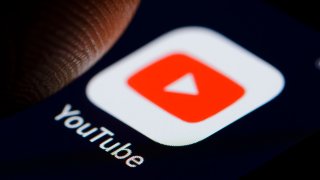
The logo of video-sharing website YouTube is displayed on a smartphone on November 19, 2018 in Berlin, Germany.
- YouTube said in an update to its terms of service this week that it has the “right to monetize” all content on its platform. As such, it said it will start putting ads on videos from channels not in its YouTube Partner Program, which shares ad revenue with creators.
- It comes after Google reported a particularly strong third quarter for YouTube, which saw ad growth at $5.04 billion, up 32% from a year ago.
- It's likely to rake in additional revenue for YouTube, but could rankle creators.
YouTube said in an update to its terms of service Wednesday that it has the "right to monetize" all content on its platform. As such, it will start putting ads on videos from channels not in its YouTube Partner Program, which shares ad revenue with creators.
The move comes after Google reported a particularly strong third quarter for YouTube, which saw ad growth at $5.04 billion, up 32% from a year ago. It's likely to increase revenues and margins for YouTube, but is sure to rankle creators who aren't eligible to make money on the platform.
Channels of any size from now on may see ads run on their videos as long as they meet its "Advertiser-Friendly Guidelines." That means videos will have to meet basic standards to minimize content like inappropriate language, hateful material, or adult content, among other restrictions.
YouTube says all videos with ads will still have to meet brand safety standards as determined by the Global Alliance for Responsible Media. The company said brand-safe content is identified using a combination of machine and human intelligence, and that ad suitability is reviewed at the video level instead of by channel. It also said advertisers can decide not to appear on those videos outside of the program if they wish.
In updates to the YouTube community, the company told creators that even if they aren't in the program, they may see ads on some of their videos.
"Since you're not currently in YPP, you won't receive a share of the revenue from these ads, though you'll still have the opportunity to apply for YPP as you normally would once you meet the eligibility requirements," it said.
The company said it will start by making the inventory outside of the YouTube Partner Program available for direct response ads in the feed of recommended videos below the video player on mobile and next to the video player YouTube's website.
YouTube won't run ads on channels that have been removed from its partner program for content violations.

